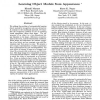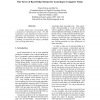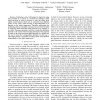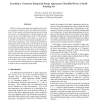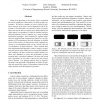144
Voted
WACV
2012
IEEE
13 years 7 months ago
2012
IEEE
We propose an online algorithm based on local sparse representation for robust object tracking. Local image patches of a target object are represented by their sparse codes with a...
119
Voted
ICASSP
2011
IEEE
14 years 4 months ago
2011
IEEE
In online tracking, the tracker evolves to reflect variations in object appearance and surroundings. This updating process is formulated as a supervised learning problem, thus a ...
117
Voted
AAAI
1993
15 years 1 months ago
1993
We address the problem of automatically learning object models for recognition and pose estimation. In contrast to the traditional approach, we formulate the recognition problem a...
82
Voted
DICTA
2007
15 years 1 months ago
2007
A scheme, named tower of knowledge (ToK), is proposed for interpreting 3D scenes. The ToK encapsulates causal dependencies between object appearance and functionality. We demonstr...
92
Voted
ICRA
2006
IEEE
15 years 6 months ago
2006
IEEE
— Positioning a robot with respect to objects by using data provided by a camera is a well known technique called visual servoing. In order to perform a task, the object must exh...
112
Voted
CVPR
2008
IEEE
15 years 6 months ago
2008
IEEE
While low-dimensional image representations have been very popular in computer vision, they suffer from two limitations: (i) they require collecting a large and varied training se...
124
Voted
ICCV
2005
IEEE
16 years 2 months ago
2005
IEEE
In recent years Kernel Principal Component Analysis (Kernel PCA) has gained much attention because of its ability to capture nonlinear image features, which are particularly impor...
101
Voted
CVPR
2006
IEEE
16 years 2 months ago
2006
IEEE
Shape is an important cue for generic object recognition but can be insufficient without other cues such as object appearance. We explore a number of ways in which the geometric a...
103
Voted
CVPR
2005
IEEE
16 years 2 months ago
2005
IEEE
Our objective is to model the visual manifold of object appearance corresponding to geometric transformation. We learn a generative model for object appearance where the appearanc...
106
Voted
CVPR
2005
IEEE
16 years 2 months ago
2005
IEEE
Statistical shape-and-texture appearance models employ image metamorphosis to form a rich, compact representation of object appearance. They achieve their efficiency by decomposin...

